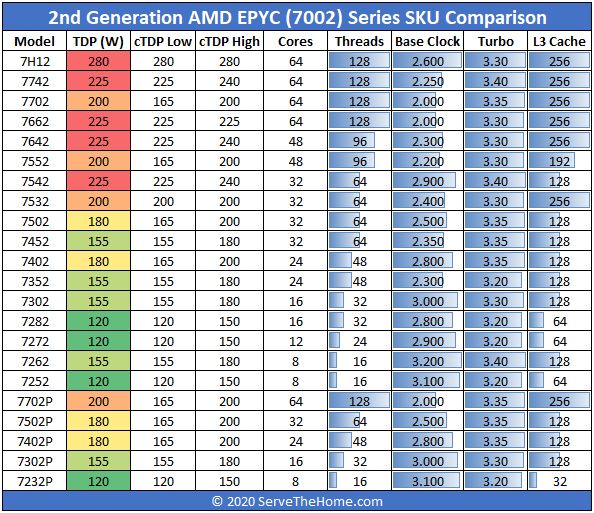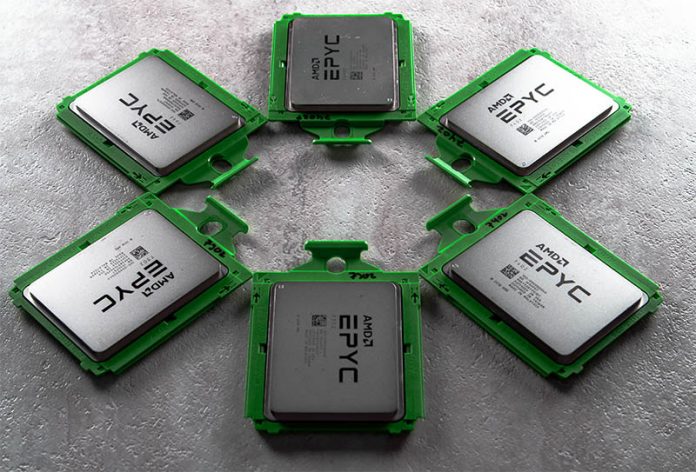AMD this morning launched two new processors, the AMD EPYC 7662 and EPYC 7532. The EPYC 7662 is a 64-core part while the EPYC 7532 is a 32-core part. This also marks the company filling out a SKU stack from a relatively smaller number of models.
AMD EPYC 7662 Overview
The AMD EPYC 7662 is a 64-core and 128-thread processor with 256MB of L3 cache. The chip has a TDP of 225W matching the highest-end mainstream (e.g. non- EPYC 7H12) CPUs.
This SKU is interesting since it seems to be an alternative to the EPYC 7702 series of processors offering a higher TDP to let the cores stay at turbo clocks longer than the launch part. We can see why some customers wanted another option since the 64-core parts are currently unique to AMD. AMD claims they have five SKUs, however, one is the EPYC 7702P a single socket only version of the EPYC 7702. AMD seems to be differentiating their stack at that 64-core level.
AMD EPYC 7532 Overview
The AMD EPYC 7532 is a 32-core and 64-thread processor with 256MB of L3 cache. The chip has a TDP of 200W. That means that this chip, like the 64-core EPYC 7662, is an eight CCD design. In other words, it has eight chiplets that are attached to the central I/O die. Each has 4 cores and 32MB of L3 cache active per chiplet.
AMD is focusing this part on applications such as ANSYS CFX that are cache intensive. With the EPYC 7532, each core gets 8MB of cache. When one compares these EPYC chips to Intel Xeon, AMD simply has significantly more cache per core.
New AMD EPYC 7002 Series SKU Stack
Here is what the new SKU stack looks like with these additions:

As you can see, the SKU numbers are becoming challenging to see in a linear fashion with the EPYC 7662 looking like it may be a match for the EPYC 7702. We are also noting that with these new parts, AMD is not using a low cTDP figure and is simply presenting one number. Perhaps this is AMD trying to simplify how they go to market with their chips.
Some may think that these are the VMware optimized SKUs mentioned in our Licenseageddon Rages as VMware Overhauls Per-Socket Licensing piece. We think that a 225W version of the EPYC 7532 will be what that chip eventually looks like. Still, for some organizations optimizing around 32-core license sets, this gives another option.
AMD says that Dell and Supermicro will now offer the two new SKUs while HPE and Lenovo will follow. We requested list pricing and will update this piece when we get it.
Update: We now have list pricing from AMD “In our standard 1Ku pricing, the 7662 is $6,150 and the 7532 is $3,350.” (Source: AMD)





You mention 7352 in paragraph 1, 4, and 5 when you mean 7532.
AMD releases new server CPU SKUs: Cool, more price points to let me optimize my builds.
Intel releases new server CPU SKUs: Crap, someone add a column to the decoder spreadsheet. They found another feature they want to make available only on limited SKUs.
Now if only they would make an 8, 16, 24, and 32 core high clock speed chip available.
Why limit cTDP High below 240W for most of the parts? For example, why not let users run the 7532 @ 240W if they want to? Just marked segmentation to drive the ASP up?
I know that some motherboards do not support 240W, but ensuring that the user cannot set a power limit in the UEFI that blows out the VRM is the responsibility of the motherboard/system vendor. As is communicating the max. VRM capacity of the system to potential customers.
Please let there be a 7H02P(currently none exist) series for the single socket Epyc(Real) Graphics Workstation market and the proper support for higher memory capacity, higher PCIe 4.0 lane counts, and 8 full memory channels with RDIMM/ECC support. Threadripper is nice and all but I’d really rather it be Epyc and some higher clocked/higher wattage Graphics Workstation parts under the Epyc Branding.
AMD needs that if it ever wants to more fully entice Apple to switch out Intel/Xeon for AMD’s Epyc on the Mac Pro, and not only just Apple but Dell’s and HP’s attention as well for single socket Graphics Workstations with way more memory bandwidth and ECC memory types/memory capacity support than Threadripper(Max 256GB) is able to support.
And seriously AMD you also need Epyc Branded Portable Workstation SKUs ASAP for that high markup market. And folks complaining about AMD maybe segmenting its product stack more while complaining about AMD not investing in software/drivers support need to remember that it’s takes more money on the software side than what is needed for actually engineering/producing the processor hardware. So AMD really needs to be hiring driver/software developers or all the great processor hardware will not be fit for its intended function.
AMD Epyc/EESC folks need to make sure that Threadripper never offers more that 256GB of capacity because market cannibalization will rob AMD of the needed funds to get its software/driver ducks in proper order. AMD need those higher markups on sales to folks that can wright that cost down against their taxes and stop worrying as much about consumer’s who can not/will not pay the higher margins that AMD needs to remain competitive with Intel and Nvidia.
Zen-3 and Epyc/Milan should rate a larger markup and that extra revenue plowed back under via way higher software/driver development funding across AMD’s entire product stack.
Given the price for – and in most cases stupid slot layout of – Threadripper boards, Epyc starts to look like the right choice for high spec workstations.
the 7662 is probably made from lower binned silicon than the other 64 core chips, that’s what the lower price, lower clocks and higher power consumption for these clocks indicate to me.
It’s all binning all the way down after the cream get skimmed off of the top but it’s better than just sitting on that bin full of die samples that could not make the grade to become the flagship of that segment. And it’s definitely better to do with lower clocks and larger L3 cache sizes if the lower bin part can at least have that advantage even if the clocks/power binning metrics are not as good as the top binning bracket requires.
Epyc/Milan and Zen-3 is dropping soon and the CCX unit gets supplanted by the CCD and all the cores on that CCD able to get at the CCD’s entire complement of L3 cache, sans any Infinity Fabric hopping and the latency added that comes along with that. And maybe for some Real Time constrained workloads Zen-3 will show a sizable improvement there for D-Pad addicted folks down on the lower rungs of the binning ladder, lower margins/markups as well. Consumer PC/Gaming oriented CPUs, not the mobile laptop variants, tend to be well clocked past that power saving metric sweet spot anyways. So some power metrics that the Server/HPC market may not accept make just fine for CCD Die samples for the consumer gaming segment. Laptop SKUs however have to be designed/binned for a different thermal envelop where cooling is more difficult in that space constrained from factor.
I’d love to read a good CS book that’s dedicated to the sciences and steps that comprise a processor maker’s binning operation and why not make that cover the entire industry’s binning operations as well. and That’s not often looked at deeply enough in the press as well but would make for some really interesting reading in a multi-part series of articles that I’d love to read.
CFX for real world problems would be very memory bandwidth intensive.
If AMD are playing loose by trying to fit the entire problem into L3 (which would be very unrealistic) – then the result could be highly skewed.
Are there any details available on the actual problems they used to illustrate performance?